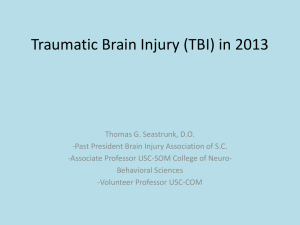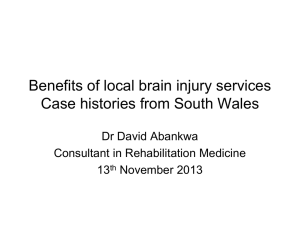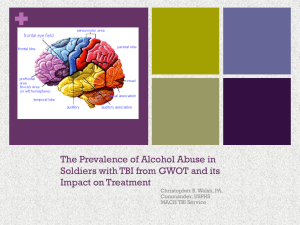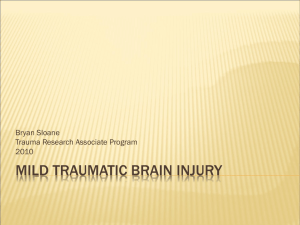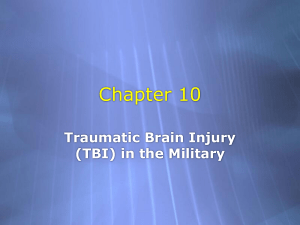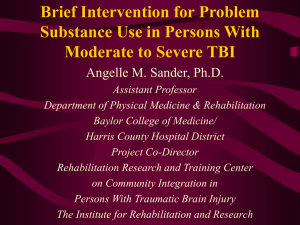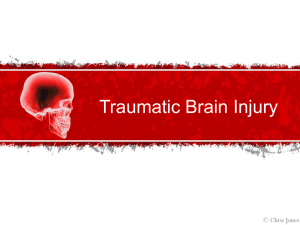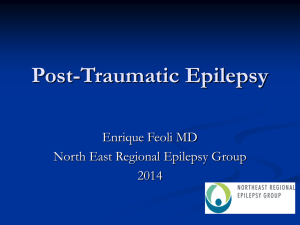Traumatic Brain Injury (TBI) - Brain Injury Association of Ohio
advertisement
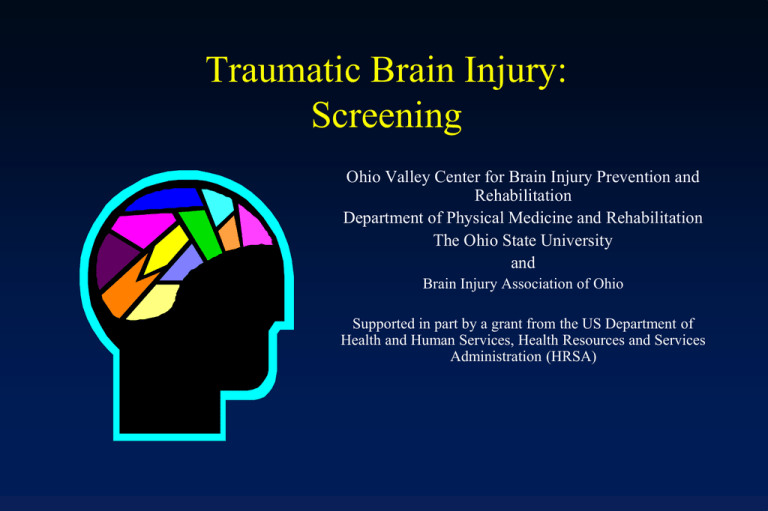
Traumatic Brain Injury: Screening Ohio Valley Center for Brain Injury Prevention and Rehabilitation Department of Physical Medicine and Rehabilitation The Ohio State University and Brain Injury Association of Ohio Supported in part by a grant from the US Department of Health and Human Services, Health Resources and Services Administration (HRSA) Why Screen for TBI? • TBI is usually not a visible disorder • Some people may not know that they have had a TBI • Documentation of a history of TBI may not be found in medical records • The effects of a TBI can have a significant impact on responsiveness to standard services or treatment methods It’s not enough to simply know whether or not someone has had a TBI Better to know lifetime history: – how many, of what severity – when they occurred (developmental & how recent) – what effect they had, or are having OSU TBI Identification Method • Structured interview designed to elicit lifetime history of TBI. • Avoids misunderstanding about what a TBI is by eliciting. injuries, then determining if TBI may have occurred. • Provides richer information about history than simple “yes/no” (e.g., number, severity, effects, timing, etc.) Administration Instructions The following slides provide instructions in the administration and scoring of the OSU TBI-ID Short Form. T-B-I Screening Trauma: an injury that includes a blow to the head, the head having impact with another object (e.g., the ground, a windshield) or substantial shaking without impact. Behavioral effect immediately: an altered state of consciousness evident in confusion, impaired memory for events around the injury, or loss of consciousness. Impact on everyday function: Following the injury, new onset or exacerbation of symptoms (e.g., headaches, dizziness, fatigue,) or function (e.g., ADL’s, managing money, employment). T-B-I Screening using the OSU TBI-ID Short Form Trauma Step 1: Questions 1-5. The goal of this step is to help the respondent recall injuries to the head or neck by reminding them about hospital visits and probing for common causes of TBI. Do not be concerned about whether a TBI occurred, only if it was possible. Questions 1-5 1. Have you ever been hospitalized or treated in an emergency room following an injury to your head or neck? Think about any childhood injuries you remember or were told about. Answer: YES (notes: car crash age 17, broken leg, hit head on windshield) Questions 1-5 2. Have you ever injured your head or neck in any other car accident or some other moving vehicle accident? For example, have you ever been in an accident involving a motorcycle or ATV? Answer: NO Questions 1-5 3. Have you ever injured your head or neck in a fall or by being hit by something? For example, have you ever fallen from a horse, fallen while rollerblading, fallen on ice or been hit by something, like a rock? Have you ever been injured playing sports or on the playground? Answer: YES, fell on ice. Questions 1-5 4. Have you ever injured your head or neck in a fight, from being hit by someone, or from being shaken violently? Have you ever been shot in the head? Answer: YES, bar fights in his 20s and 2 recent assaults on the street Questions 1-5 5. Have you ever been nearby when an explosion or a blast occurred? If you served in the military, think about any combat-related incidents. Answer: NO Question 6 If any of questions 1-5 were answered YES, then proceed to Question 6 for each injury that was mentioned: • Were you knocked out or unconscious following any of the injuries that you mentioned before (do NOT include loss of consciousness due to overdose or choking here, see question 7). • If there was loss of consciousness, ask the person to estimate how long • If there was no loss of consciousness, ask the person if he or she was dazed or confused, or had gap in memory Question 6 6. Were you knocked out or unconscious following any of the injuries you mentioned before? Were you knocked out when you: • Were in the car crash at age 17, hitting your head on the windshield and breaking your leg? Answer: YES How long were you knocked out? Answer: 15 minutes (we already know he was 17) Question 6 • • Were you knocked out when you fell on ice: Answer: NO Were you knocked out in any of the bar fights in your 20s? Answer: YES, many of them (Proceed to 7B) Do you recall any of the fights in detail? Answer: NO, they are blurred together Can you tell me the longest time period that you were knocked out? Answer: 5 MINUTES (never longer than) At what age did the fights start and end: Answer: 20-30 Question 6 • Were you knocked out when you were assaulted on the street recently? Answer: Not the first time, but YES for the 2nd assault. How long were you knocked out? Answer: ONE HOUR How old were you at the time? Answer: 67 Question 7 Have you ever lost consciousness from a drug overdose or being choked? Impact on everyday function: Step 3: eliminated from the short form. Can be explored in clinical interview with a question like: “After that injury at age ___ did you have any problems caused by the injury that you didn’t have before or that got worse due to the injury?” For any problems identified, ask “Is that still a problem now?” Special Interviewing Issue: Multiple Mild TBI’s • Some people have had multiple, mild injuries in a short period of time, due to a single cause – They will have problems remembering the details of those injuries, including how many – It may be enough to know that there was a period like this, when it was, and how severe the worst injury was during this time – Note that some people may have had more than one of these periods in their life – In terms of treatment, knowing the cause of these injuries may be helpful Scoring # TBI-LOC (number of TBI’s with loss of consciousness from 6) # TBI-LOC ≥ 30 (number of TBI’s with loss of consciousness ≥ 30 minutes from 6) age at first TBI-LOC (youngest age from 6) TBI-LOC before age 15 (if youngest age from 6 < 15 then =1, if ≥ 15 then = 0) Scoring (continued) Worst Injury (1-5): If responses to #1-5 are “no” classify as 1 “improbable TBI”. If in response to #6 reports never being dazed or having memory lapses classify as 1 “improbable TBI”. If in response to #6 reports being dazed or having a memory lapse classify as 2 “possible TBI”. If in response to #6 loss of consciousness (LOC) does not exceed 30 minutes for any injury classify as 3 “mild TBI”. If in response to #6 LOC for any one injury is between 30 minutes and 24 hours classify as 4 “moderate TBI”. If in response to #6 LOC for any one injury exceeds 24 hours classify as 5 “severe TBI”. # anoxic injuries (sum of incidents reported in #7) Age at which an injury occurs may be an important aspect of lifetime history of TBI • Age at first injury with loss of consciousness demonstrated the largest number and magnitude of relationships with current cognitive performance and self-reported behavioral problems • Symptoms experienced initially after injury, especially childhood injuries, were found to be associated with adult impairments • Results suggested a relationship between number of lifetime injuries and childhood developmental and adult medical conditions Number and Severity of Injuries • Three scores focus on either a combination of number and severity of injury, or severity of the worst injury • These scores have been found to be associated with cognitive and behavioral difficulties. Example Scoring • • • • • • #TBI-LOC: 3 #TBI-LOC>=30: 1 Age at first TBI-LOC: 17 TBI-LOC before age 15: 0 Worst injury: 4 # anoxic injuries: 0 Interpretation of Scores • The scores that Jack received indicate that there is a high likelihood that he was exposed to multiple TBIs in his lifetime. Exposure seemed to have begun by late adolescence. The worst injury was of moderate severity and was within the past year. Interpretation of Scores • The indicators of exposure to TBI discussed in the previous slide suggest that it is likely that Jack is experiencing cognitive and behavioral consequences from his injuries. Some of the consequences may have been present for some time, while others may have occurred as a result of the most recent injury. Some effects of previous injuries may have worsened after the most recent injury. Resources • • • • • • www.ohiovalley.org www.tbinetwork.org www.biaoh.org www.biaa.org www.brainline.org www.cdc.gov Thank you. Jennifer Brello, M.Ed., CCC-SLP Program Director Ohio Valley Center for Brain Injury Prevention and Rehabilitation Brello.1@osu.edu

